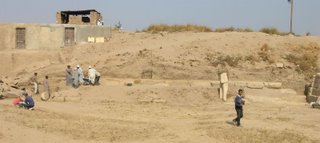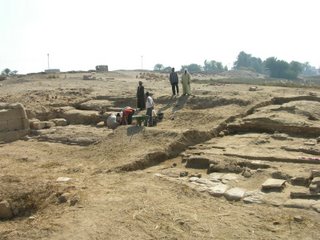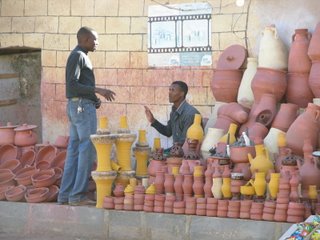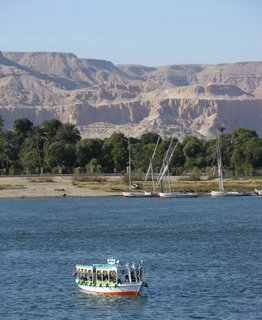 The early morning light filters through the dust as we get back to work on the first day after the break for the Eid el Adha and Coptic Christmas. We have had a busy week.
The early morning light filters through the dust as we get back to work on the first day after the break for the Eid el Adha and Coptic Christmas. We have had a busy week. One of our projects this year is to re-organize the many blocks of temple decoration and pieces of Sakhmet statues discovered over the years. Moving even the upper half of a single Sakhmet statue from the storage magazine to its new location is hard work.
One of our projects this year is to re-organize the many blocks of temple decoration and pieces of Sakhmet statues discovered over the years. Moving even the upper half of a single Sakhmet statue from the storage magazine to its new location is hard work. Thanks to the strength and skill of our workmen, we were able to consolidate all the fragmentary Sakhmet statues onto a single new mastaba.
Thanks to the strength and skill of our workmen, we were able to consolidate all the fragmentary Sakhmet statues onto a single new mastaba. This is the original "mastaba" (Arabic for "bench") we built many years ago to hold decorated blocks and pieces of statues. Mastabas are constructed of baked brick and cement with a layer of bitumen cloth between the courses to act as a barrier to ground water.
This is the original "mastaba" (Arabic for "bench") we built many years ago to hold decorated blocks and pieces of statues. Mastabas are constructed of baked brick and cement with a layer of bitumen cloth between the courses to act as a barrier to ground water. We are hoping to be able to reconstruct more of Chapel D using blocks from there uncovered in the 1970s. To make reconstruction easier, we have built 3 new mastabas just to the east of the chapel and have started organizing the blocks.
We are hoping to be able to reconstruct more of Chapel D using blocks from there uncovered in the 1970s. To make reconstruction easier, we have built 3 new mastabas just to the east of the chapel and have started organizing the blocks. On January 8 Dr. Jacobus van Dijk of the University of Groningen arrived joined the expedition. Richard and he were in Chapel D discussing work there when I interrupted them for a photo.
On January 8 Dr. Jacobus van Dijk of the University of Groningen arrived joined the expedition. Richard and he were in Chapel D discussing work there when I interrupted them for a photo. An urgent conservation project for 2007 is the restoration of the east wall of the East Porch of the Mut Temple. Its foundations are deteriorating to the point that a fox has been able to dig a den under one of the columns. The sandstone and limestone blocks of the upper parts of the wall are decayed as well.
An urgent conservation project for 2007 is the restoration of the east wall of the East Porch of the Mut Temple. Its foundations are deteriorating to the point that a fox has been able to dig a den under one of the columns. The sandstone and limestone blocks of the upper parts of the wall are decayed as well. We are fortunate this year to have the SCA conservator, Khaled Mohammed Wassel (right) working with us again. Here he, Richard, Jaap, and our inspector Mouna discuss the work to be done in the East Porch.
We are fortunate this year to have the SCA conservator, Khaled Mohammed Wassel (right) working with us again. Here he, Richard, Jaap, and our inspector Mouna discuss the work to be done in the East Porch. Before work could begin on the foundations of the column, we had to shore it up with metal supports to prevent its collapse.
Before work could begin on the foundations of the column, we had to shore it up with metal supports to prevent its collapse. By the end of work on Thursday the basic restoration work on the south part of the wall and on the column's foundations had been completed. The rough new surfaces will be coated with a layer of material tinted to match the stone, as has been done elsewhere in the site. Now we have to dismantle and restore the wall to the north (left) of the column.
By the end of work on Thursday the basic restoration work on the south part of the wall and on the column's foundations had been completed. The rough new surfaces will be coated with a layer of material tinted to match the stone, as has been done elsewhere in the site. Now we have to dismantle and restore the wall to the north (left) of the column. Excavation in the Forecourt of Temple A also proceeded while all the block moving and restoration were going on. The south edge of the north wall has been uncovered along its entire length. In order to go any further, however, we are going to have to remove much of the mountain of earth and decayed brick that has collapsed onto the wall. We need to do this both to prevent any possible collapse of the mound and to try to find the face of the Precinct's enclosure wall behind the Forecourt.
Excavation in the Forecourt of Temple A also proceeded while all the block moving and restoration were going on. The south edge of the north wall has been uncovered along its entire length. In order to go any further, however, we are going to have to remove much of the mountain of earth and decayed brick that has collapsed onto the wall. We need to do this both to prevent any possible collapse of the mound and to try to find the face of the Precinct's enclosure wall behind the Forecourt. We are continuing to trace the limestone and brick walls that form the south side of the Forecourt. By sometime next week the two squares should meet and we'll have a clearer idea of the relation between the various features we are uncovering. So far there has been little pottery uncovered in either area.
We are continuing to trace the limestone and brick walls that form the south side of the Forecourt. By sometime next week the two squares should meet and we'll have a clearer idea of the relation between the various features we are uncovering. So far there has been little pottery uncovered in either area.
 Locally made pottery is still important to the people of Luxor. With the exception of the few stone cats and small obelisks, all the wares displayed by this potter are for everyday use.
Locally made pottery is still important to the people of Luxor. With the exception of the few stone cats and small obelisks, all the wares displayed by this potter are for everyday use.
We were fascinated to watch this wall along the road to the Mut Temple being prepared for decoration just as pharaonic artists prepared tomb and temples walls. The wall has been smoothed and gridlines drawn. Using the grid to scale up preliminary sketches, local artists have drawn the outlines of the decoration just as their ancient counterparts did. The next step will be to fill in the outlines. We aren't sure whether this is to be a painting or a mosaic. We'll follow its progress.
 On a sunny, bright day in Luxor (which, let's face it, is most days) the view across the Nile to the hills of the west is breathtaking. No matter how hot and dusty we may be, spending a few moments looking at scenery like this refreshes us all.
On a sunny, bright day in Luxor (which, let's face it, is most days) the view across the Nile to the hills of the west is breathtaking. No matter how hot and dusty we may be, spending a few moments looking at scenery like this refreshes us all.
Mary McKercher
Photographer





